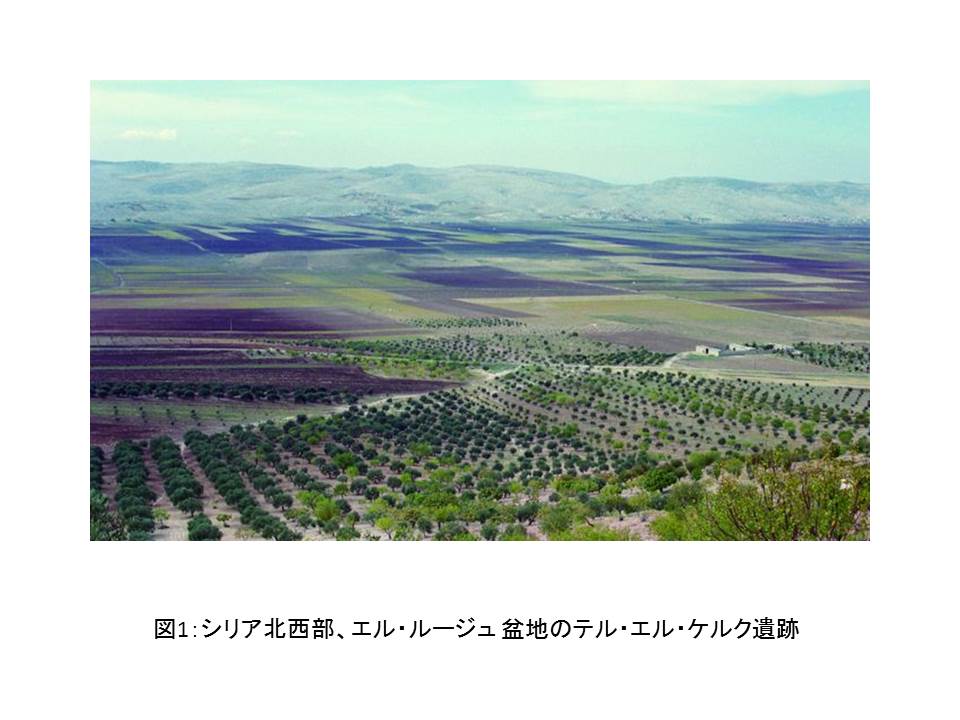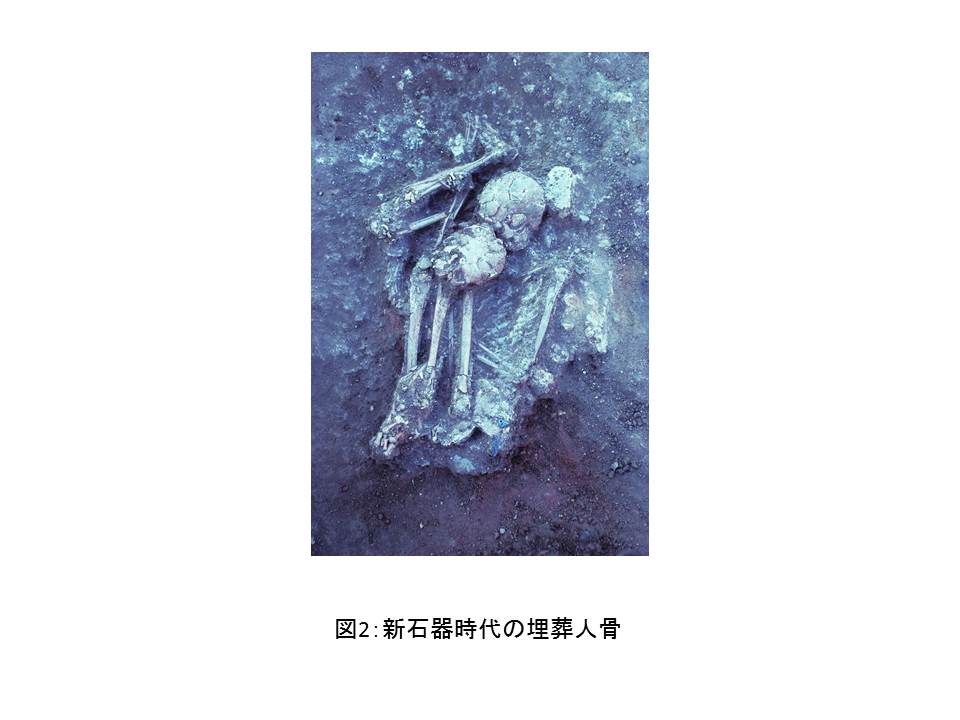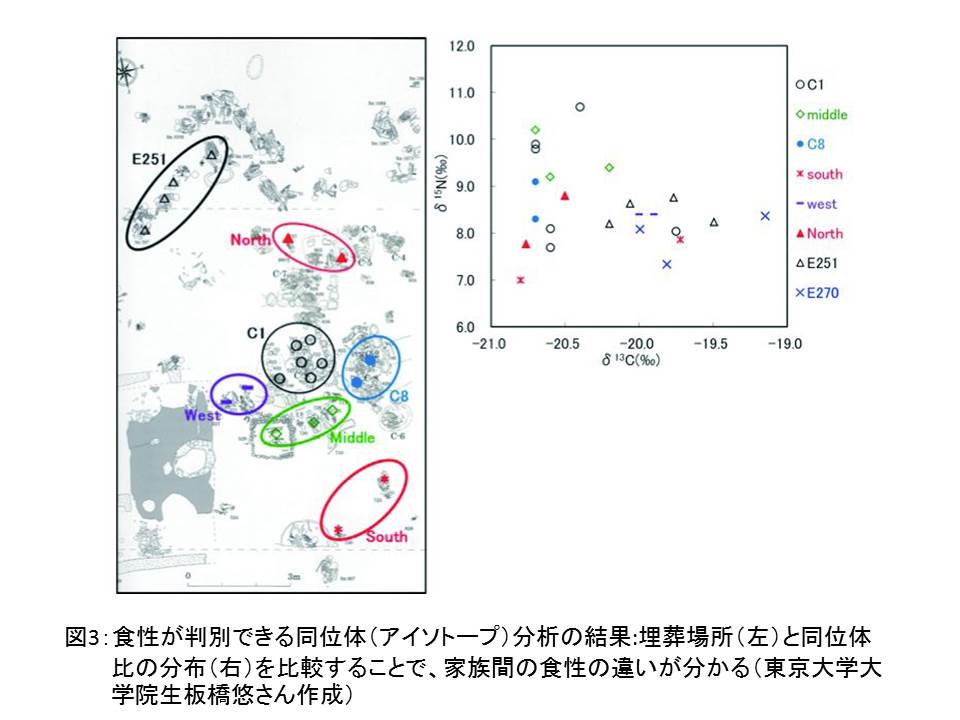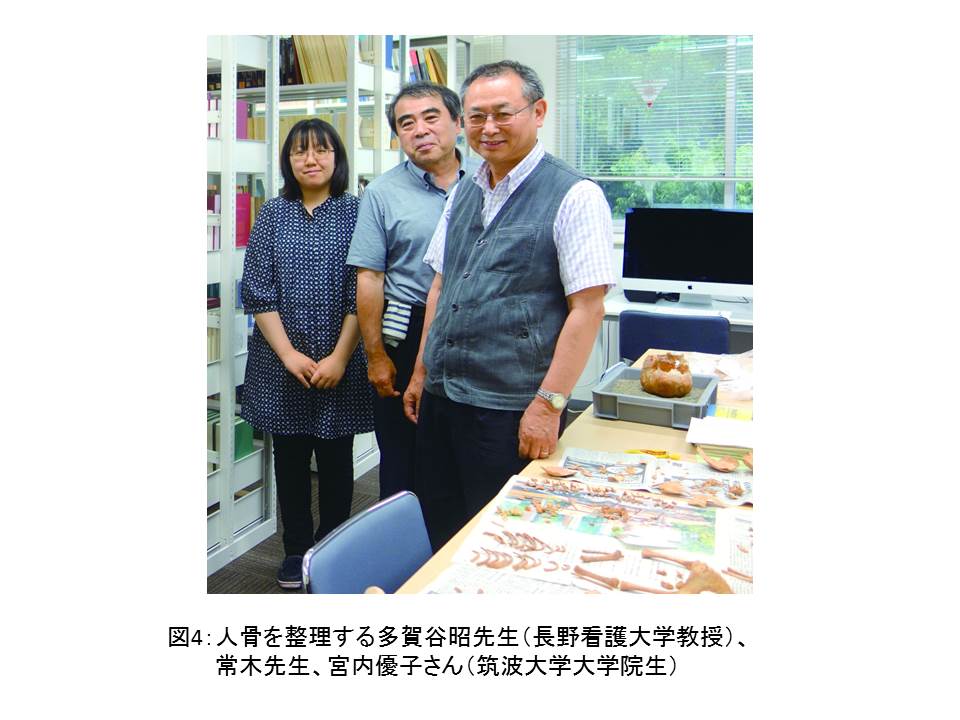キーワード:西アジア新石器時代、人骨、同位体比分析、食性、婚姻
http://rcwasia.hass.tsukuba.ac.jp/
 古代西アジア、つまり現在のシリアやトルコ、イラン、イラクとその周辺で文明が始まったのは約一万年前です。このリサーチユニットは、その古代社会の全貌を解明するべく研究をしています。アフリカから西アジアへ拡散した人類は、どのようにして定住や農耕を始め、いかにして冶金術や文字の創造、都市の形成をなし得たのでしょう。小麦栽培やビール、ワイン醸造、そしてチーズ等の発酵食品の起源も西アジアにあります。西アジアの遺跡の調査は、現在に繋がる人間社会の基盤を解明する鍵となるものです。
古代西アジア、つまり現在のシリアやトルコ、イラン、イラクとその周辺で文明が始まったのは約一万年前です。このリサーチユニットは、その古代社会の全貌を解明するべく研究をしています。アフリカから西アジアへ拡散した人類は、どのようにして定住や農耕を始め、いかにして冶金術や文字の創造、都市の形成をなし得たのでしょう。小麦栽培やビール、ワイン醸造、そしてチーズ等の発酵食品の起源も西アジアにあります。西アジアの遺跡の調査は、現在に繋がる人間社会の基盤を解明する鍵となるものです。
埋葬人骨の化学的分析によって、8千年前の人々の食性を復元する
人の骨にはその人のパーソナルヒストリーが刻まれています。例えば、同位体(アイソトープ)分析により骨の中の窒素同位体と炭素同位体の比を調べると、その人がどんな食物を多く摂っていたのかが分かります。紀元前6300年頃の北西シリアの村の遺跡(図1)から発掘された240体の人骨(図2)を調べると、同じ遺跡から出土した動物骨や植物種子などからも想定されるとおり、当時の人々は小麦などの穀物や豆、羊・山羊・豚・牛といった4種の家畜に頼っていたことが判明しました。また、上記同位体比が共同体墓地内の埋葬場所によって少しずつ異なることから、家族ごとに食事を摂っていたと思われます(図3)。さらに、骨からは病気の痕や成長期の栄養状態をも読み取ることができます。



DNAサンプルの採取が難しい人骨から、同位体分析を用いて婚姻関係を解明する
ストロンチウム同位体は水や食べ物を通じて体内に取りこまれ、15歳くらいまで骨に蓄積されます。このストロンチウム同位体の比率は地域ごとに異なる特徴をもっています。前述の北西シリアの成人人骨はすべてエル・ルージュ盆地(南北約30km、東西3~4km)内で幼少期を過ごした人のものと判明しました。つまり、盆地の外とも経済的交流があったことは知られていますが、婚姻関係は同地域の中、おそらくは親族の中で結ばれていたと考えられます。また、家族関係については、遺伝性の骨の形態からも推定されます。

社会への貢献・実績
● 新たな分析法により先史時代の人々の生活を実証的かつヴィジュアルに復元
● 学術的には重要でも現在アプローチが困難な地域の資料の活用
● 西アジア文明研究の発展に寄与
(取材:平成25年6月20日)
An overall picture of the lives of people who lived in civilized societies in Ancient West Asia
Unit name: Research Unit for Studying Prehistoric Diet and Matrimony by Isotope Analysis
Key words:Neolithic period in West Asia, human remains, isotope ratio analysis, dietary habits, marital relationships
 Civilization originated in Ancient West Asia, or Syria, Turkey, Iran, Iraq, and their surrounding areas as we know them today, approximately 10,000 years ago. The research unit is involved in research to understand the overall picture of Ancient West Asian societies. Some people in Africa moved to West Asia. How did they settle there, start to grow crops, invent metallurgical technology and languages, and develop cities? The cultivation of wheat, brewing of beer and wine, and production of fermented food such as cheese also originated in West Asia. Research on remains in West Asia, which led to modern society, is the key to clarifying the basis of modern human society.
Civilization originated in Ancient West Asia, or Syria, Turkey, Iran, Iraq, and their surrounding areas as we know them today, approximately 10,000 years ago. The research unit is involved in research to understand the overall picture of Ancient West Asian societies. Some people in Africa moved to West Asia. How did they settle there, start to grow crops, invent metallurgical technology and languages, and develop cities? The cultivation of wheat, brewing of beer and wine, and production of fermented food such as cheese also originated in West Asia. Research on remains in West Asia, which led to modern society, is the key to clarifying the basis of modern human society.
Reproduction of the dietary habits of people dating back 8,000 years by chemical analysis of buried human remains
The history of a person is inscribed in his/her bones. For example, the ratio between nitrogen and carbon isotopes contained in the bones of a person, determined by isotope analysis, suggests what food was favored by the person. Our study, involving the bones of 240 people who lived around 6,300 B.C. excavated from the remains of a village located in Northwest Syria (Figure 1), along with animal bones and seeds, suggests that they primarily fed on wheat and cereal such as beans and their lives were supported by four kinds of livestock: sheep, goat, pigs, and cows. In addition, the above-mentioned ratio of isotopes varied depending on the burial place in a community cemetery, which suggests that meals were eaten in units of families (Figure 3). The bones of people also include information on their histories of illness and nutritional conditions during the developmental period.



Determination of marital relationships by isotope analysis of human bones despite the difficulty of DNA sampling
Strontium isotopes contained in water and food are taken into the bodies of people and continue to be accumulated in the bones until they reach approximately 15 years old. The strontium isotopic ratio varies depending on the area in which the person lives. The results of our study suggested that all of the bones of adults excavated in Northwest Syria belonged to people who spent their early childhood in the Rouj Basin (north-south length: approximately 30 km, east-west length: 3 to 4 km). This means that, although there were economic exchanges between people living inside and outside the Rouj Basin, people in the basin may have married only those living in the same area or their relatives. Assumptions regarding such relationships are also made based on the morphological characteristics of bones that are heritable.
The University of Tsukuba has a collection of bones from approximately 120 people who lived in the Neolithic period excavated from remains located in Northeast Iran (Figure 4). The research unit conducts isotope analysis of these bones to further examine the ancient civilization and society.

Social contributions and achievements
● Visual reproduction of the lives of prehistoric people using a new empirical analysis method
● Utilization of academically important information on areas that cannot be easily accessed
● Contribution to advancement in research on West Asian civilization
